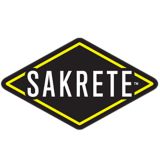The Sakrete Story
In 1936, in Toledo, Ohio, a young mining engineer named Art Avril, and his wife Mary, created a successful ready-mix concrete supply company. Art Avril created something of a revolution in the construction industry. He changed the way concrete was specified when he ignored the arbitrary mix proportions outlined by the engineers who designed the new Cincinnati Union Terminal, and convinced them to allow him to price concrete by its compressive strength. This practice was accepted for the first time in 1936, and has become the standard for specifying concrete today!
Soon after the formation of his ready-mix company, Art began to notice that people frequently would come to him requesting a bucket or shovelful of “drippings” from returning ready-mix trucks. They had a small job to complete around the house and simply did not need the minimum, one or two cubic yards of concrete. Art reasoned that there might be a market for a pre-bagged, dry concrete that homeowners and small contractors could mix and use as needed.
Art also knew that the average homeowner did not have the knowledge or ability to mix consistently good, strong concrete. Understanding the technology behind the production of good quality concrete, Art Avril sought a process that provided a dry material, a package with a moisture barrier, and a system that would incorporate these components into a single easy-to-use unit. He sourced a multi-use paper bag with a vapour barrier, found an asphalt plant that would dry his sand and stone, combined these products with cement and his knowledge of concrete mix designs, and immediately patented the system.
The only part of Art Avril’s new product that was missing was a name. Art and his wife Mary developed a list of over 50 possibilities and randomly pulled the name “SAKRETE”. That name is now recognized around the world and is available in Canada, the United States, the Far East, Western Europe and Latin America, from more than 80 production plants.
By 1945, the Atlas Lime Company of El Paso, Texas, read about Art Avril’s success through an article in a concrete magazine and contacted Art to express their interest in his system. By mid-August, the Atlas Lime Company became SAKRETE’s first of many licensees to manufacture SAKRETE on a regional basis.
Later that same year, Art Avril received a phone call from Guy Campbell of Harry T. Campbell Sons Corp. in Baltimore, Maryland. Guy invited Art to visit their faculty and soon after, Harry T. Campbell Company (which was later acquired by the Flintkote Company) became SAKRETE’s second licensee.
Sakrete Canada
SAKRETE expanded into Canada when a license was granted to Flintkote Company of Canada to produce SAKRETE products in its new production facility in Paris, Ontario.
The SAKRETE Division of The Flintkote Company of Canada shipped less than 2,000 tonnes of product out of its new Oak Park production plant, during its first year. Despite this modestly successful start, the SAKRETE Division was the only plant in Canada capable of producing a pre-blended, pre-packaged concrete mix.
However during the rapidly growing 1960s, more homeowners discovered the convenience of SAKRETE products and the phenomenon of ever-expanding subdivisions fuelled a construction boom. This meant more and more growth for the SAKRETE Products Division.
Although the company owned the rights to produce SAKRETE products in Eastern Canada, Flintkote’s SAKRETE Division operated out of one plant, which only serviced the Ontario market. By 1971, a small dry-mix concrete blending operation located at the North boundary of Montreal, at Ste-Therese de Blainville, was purchased by The Flintkote Company of Canada. Production of SAKRETE products at the new plant began immediately and the SAKRETE Division was now capable of servicing the rapidly-growing Quebec market.
In a management buy-out called the “Genstar Sell-Off”, the SAKRETE Division and the Construction Division were purchased by a team of Senior Genstar Managers, made up of Hank Hutter, Hugh MacPherson and Fred Whittaker. After purchasing the SAKRETE and Construction Divisions, the first decision made by the new owners was to bring back the King name.
Over the next 25 years, the five SAKRETE brand products joined an ever growing list of KING branded, D-I-Y and contractor-based products, as marketed by the Consumer Group of King Packaged Materials Company, now a company acquired by Sika in 2019. With the advent of big box stores, the need for illustrative as well as easy-to-understand packaging and merchandising material became mandatory.
About Sika Canada
Sika has been present in Canada since 1957 through its subsidiary - Sika Canada Inc. The Pointe-Claire site, located near Montreal, houses the head office for all Canadian operations, which includes the research & development, administration, sales, and marketing departments, including a production plant and a main distribution centre serving the entire country. These facilities operate under dual certification - ISO 9001 for quality management systems and ISO 14001 for environmental management systems. With regional offices and manufacturing facilities located in Boisbriand, Quebec; Mississauga, Cambridge, Oakville, Sudbury, Ontario; Edmonton, Alberta; and Surrey, British Columbia, Sika Canada employs more than 400 people and is able to effectively share its international expertise with local customers and stakeholders.

